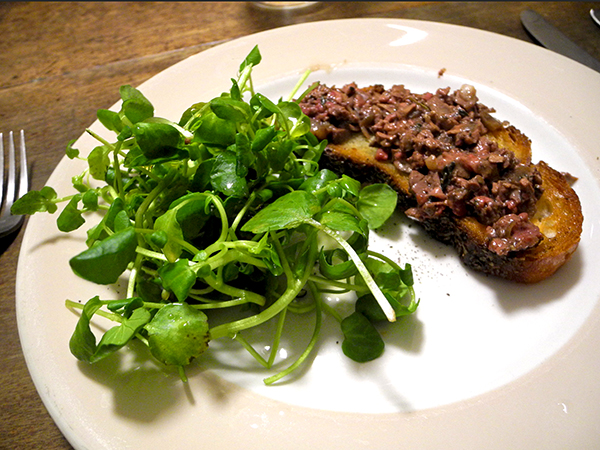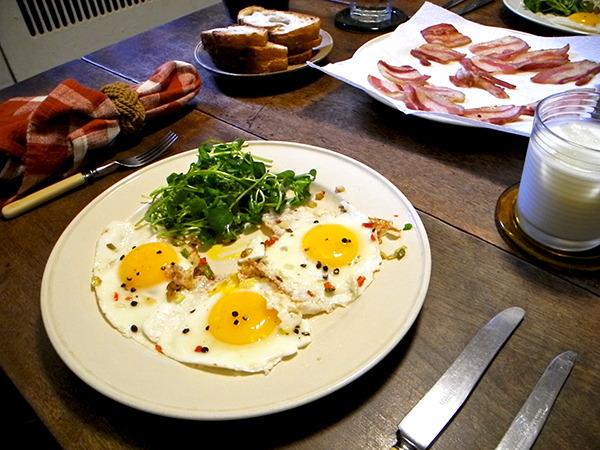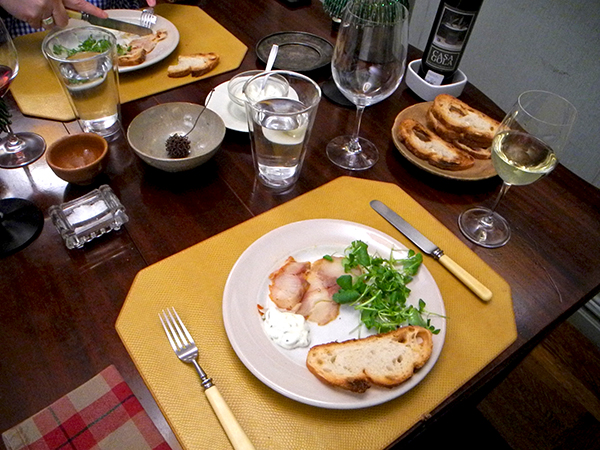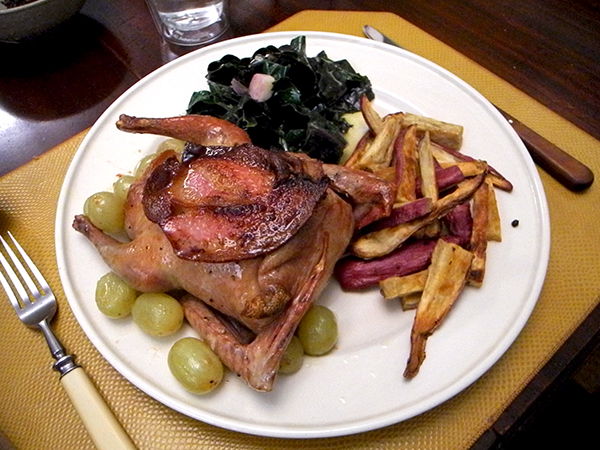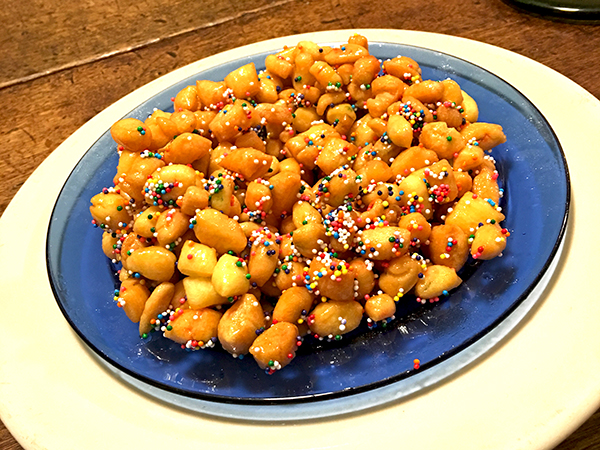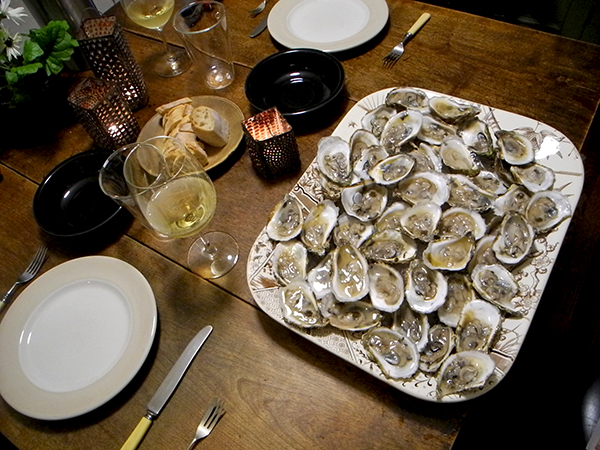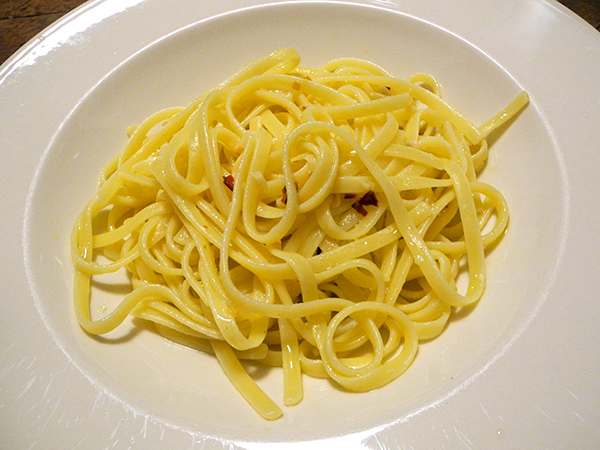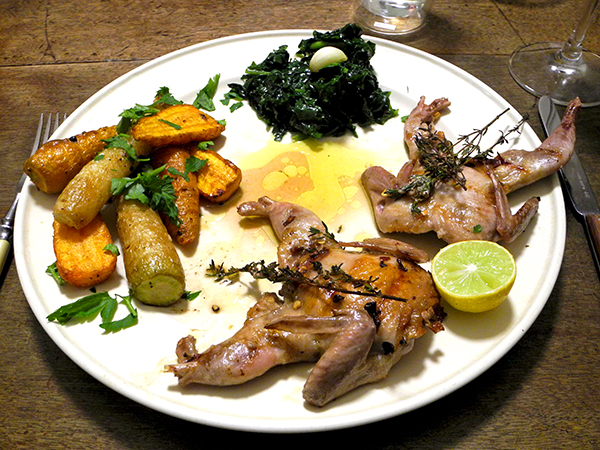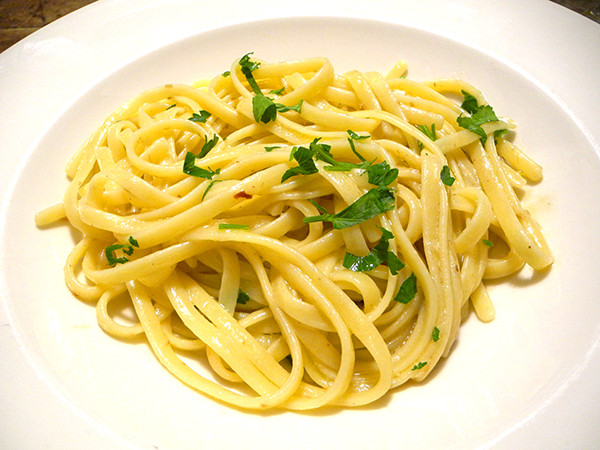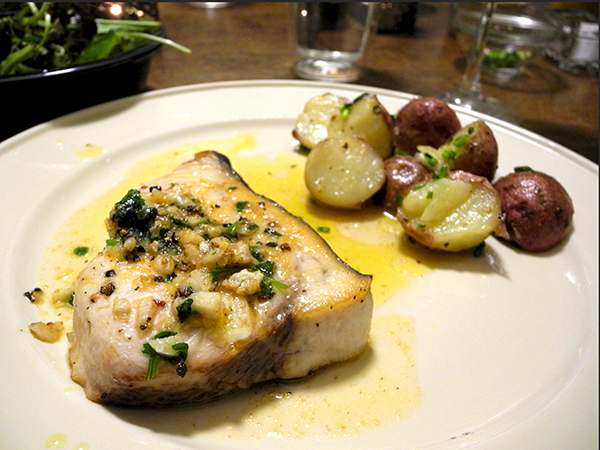- one 14-ounce fillet of wild Coho salmon from Whole foods, cut into two servings, placed, skin side up, in an oval, enameled cast iron pan in which about two tablespoons of unsalted ‘Kerrygold Pure Irish Butter‘ (with 12 g total fat; when every other one available here has 11) had been allowed to heat until the foam began to recede, then placed in a 450º oven for about 7 minutes, or until barely cooked, flipped a little more than half way through, removed, arranged on plates, sprinkled with Maldon salt, freshly-ground Tellicherry pepper, and chopped tarragon from Stokes Farm
- small red potatoes from Stokes Farm, boiled in well-salted water, drained, dried in the still-warm glass pot, rolled in a little butter, scattered with salt and pepper, and sprinkled with scissored slices from 6 or 7 whole baby chive plants from Rogowski Farm
- beautiful slightly-curly arugula from Keith’s Farm, and a small amount of watercress from Max Creek Hatchery, briefly warmed in a little butter, seasoned with salt and pepper, and sprinkled with a bit of juice of a very small lemon/lime citrus fruit from Fantastic Gardens
- the wine was a very good Oregon (Willamette Valley) red, Ponzi Tavola Pinot Noir 2012, from Astor WInes and Spirits
- the music was a part of the continuing WQXR annual 10-day, year-end Bach Festival, which at this time featured music for the feast of the Assumption
squab bruschetta, cress; caprese ravioli, tomato, ricotta
almost the definition of a rich dish (with a fresh spicy green as foil)
A significant part of this meal was composed of leftovers, and that explains the quirkiness of the order of courses. Also, my heart was in the bruschetta; the pasta was essentially an afterthought.
I was able to extend our enjoyment of the squab another night by putting together the makings of a bruschetta. It all got a little confusing during the process because I had also decided to prepare a rich broth with the necks and the gizzards; because of the late hour, I ended up doing both at the same time, and there was a duplication in the remaining ingredients of the chopped liver and the stock. There was lots of, ‘which pan does this go into?’
The stock I made, almost as important as what the squab contributed, as a rich pâté, to the first course of this meal, will stretch these birds still further, to at least to one more visit.
Finally, I can’t say enough about the importance of the goose fat to this meal, to that of the night before, and to those that are yet to come. Thank you Michelle.
- a little goose grease, the gift of a friend, heated until hot in a small non-reactive pan, in this case a vintage Corning Pyrex Flameware blue-glass pot, the heat turned off, and two squab hearts from the birds enjoyed the night before, halved, and two livers seared for 30-45 seconds or so, removed from the pan, which was returned to the heat and sliced shallots from Phillips Farm, chopped thyme from Stokes Farm added to the goose fat and cooked for a brief minute or so, a bit of cognac introduced to deglaze the mix, boiled down for a minute or two, or until the alcohol has evaporated, removed from the pan, seasoned with a bit of salt and finely-ground pepper, and finely chopped together with the liver an heart pieces, a small amount of zest from a very small lemon/lime citrus fruit from Fantastic Gardens, spread on top of two pan-toasted slices of Grand Daisy Pugliese Pane from Whole Foods (there should probably been some chopped thyme or parsely on the top of the pâté, and I should have first rubbed the toast with cut garlic cloves, but I forgot to do both in my rush)
- cress from Max Creek Hatchery, dressed with good olive oil, lemon/line juice from the same tiny fruit, salt, and pepper
- the wine was an Italian (Sicily) red, Tenuta Rapitlà Nero d’Avola Campo Reale 2013
- Rana ‘Ravioli Caprese Duet‘ (two colors and two fillings: tomato mozzarella and basil pesto) from Eataly, boiled for about 2 minutes, stirred into a bowl with a sauce, prepared in a small non-reactive pan, with a little olive oil, chopped garlic, half of one pepperoncino, 4 large-ish Backyard Farms Maine ‘cocktail tomatoes’ from Whole Foods, halved, spicy arugula from Keith’s Farm, torn, finished by tossing with some ricotta Liuzzi Angelini from Eataly
- the wine was an Oregon white, A to Z Oregon Chardonnay 2013
- the music throughout was the continuing WQXR annual 10-day, year-end Bach Festival
bacon and eggs and fresh red pepper and cress and toast
sometimes the classics are enough, but they can always take a bit of a tweak
It was the Feast of St. Stephen, a holiday in many Christian parts, suggesting the need for a special breakfast to begin the day. We really wanted eggs, and we had all the fixings. Somehow we had already misplaced all of the morning hours by the time we discussed this, so, while it looks like breakfast, I’ll call the meal lunch, in fact it was a late lunch.
- the eggs were from Millport Dairy, as was the thick, ‘country-style’ bacon; the cress was from Max Creek Hatchery, and it was dressed with a good Umbrian olive oil (Luciana Cerbini Casa Gola), from Buon Italia and a small squeeze of a small lemon/line citrus fruit from Fantastic Gardens; the toast was Grand Daisy Pugliese Pane, from Whole Foods; the eggs were sprinkled with half of one not-so-very-hot Cayenne thin red pepper from Oak Grove Plantation; there was salt and pepper on both the greens and the eggs;
- there was Trickling Springs Creamery whole milk, and afterwards, espresso
- the music was still more of WQXR‘s annual 10-day, year-end Bach Festival, which will be streaming until midnight, New Years Eve
cod; squab, juniper, grapes; sweet potato; collards; struffoli
it seems Barry couldn’t wait to start, but it had been some time since lunch
It was the 25th of December, and so it was an almost perfect excuse for a feast.
- 3 ounces of smoked wild Alaskan black cod (sable) from Blue Hill Bay Smoked Seafood, via The Lobster Place, brought to room temperature and served with a sauce of créme Fraîche from Ronnybrook Farms stirred with zest and juice from an unidentified small citrus fruit from Fantastic Gardens (it looked and tasted a bit like a ripe, small yellow lime), 5 whole tiny chive plants from Rogowski Farm, scissored from the bottom all the way into the green tops, and a little chopped tarragon from Stokes Farm, with cress from Max Creek Hatchery, dressed with good olive oil and more lemon/line juice, and some Grand Daisy Pugliese toasts on the side
- the wine was a German (Pfalz) white, Becker Family Pinot Blanc, 2013, which Appellation Wines was kind enough to special order for us when we asked them to
Pigeon. These weren’t wood pigeons, which are smaller, leaner, tastier, but wild, and therefore cannot be sold inside the U.S., but these domestic squab were almost as delicious, and at least there were no worries about biting into shot.
- 2 air-chilled California squab from D’Artagnan, via O. Ottomanelli & Sons Meat Market, seasoned with salt and pepper inside and out, cooked, breast side down, in rendered goose fat (gifted from our hosts the night before), turning a few times, until richly browned all over (about 12 minutes), before being transferred to a tin-lined copper au gratin pan, the cavities rubbed with 2 tablespoons of softened butter which had been mixed with 2 teaspoons of crushed juniper berries, each bird covered with a round of sliced guanciale (also from O. Ottomanelli & Sons), then surrounded in the pan by nearly a cup of seedless California white grapes from Whole Foods, placed in the upper third of a 450º oven for about 15-20 minutes, or until the thickest part of the thighs had been cooked to medium-rare, removed and let rest for about 5 minutes
- Japanese sweet potatoes from Lani’s Farm, unpeeled, but washed thoroughly, cut as french fries, tossed in a bowl with olive oil, salt, and pepper, than roasted above 400º in my trusty well-seasoned Pampered Chef unglazed ceramic oven pan for about 35-40 minutes
- red collard greens from Tamarack Hollow Farm, cut in a rough chiffonade, then braised in a heavy pot in which one halved rocambole garlic head from Keith’s Farm had been allowed to sweat in some olive oil, the dish finished with salt, pepper, a drizzle of olive oil, and a sprinkle of juice from the same lemon/lime described above
- the wine was an Italian (Sicily) white, Benanti Etna Rosso, Rosso di Verzella 2013, from Flatiron Wines & Spirits
If I retain any Christmas traditions from any of my past lives, struffoli is one of them, and it can always make me smile.
- the struffoli was from Buon Italia
- the music was a continuation of WQXR‘s annual 10-day, year-end Bach Festival, streaming until midnight, New Years Eve
tons of oysters; followed by the simplest pasta of all
The meal was just about as simple as anything I’d ever served, although there was a certain amount of labor involved for both of us, in what I will call the process which brought it to the table.
The most fun of those labors brought Barry and I out of the rain yesterday, once again, for a journey to the Village rooftop where we met our contact, and shared a few oysters, beer, and wine.
Less fun, but with the pleasure and reward of work done well, was the job of opening the 4 dozen bivalves once we got home.
Enjoying them at leisure brought us back to the real fun.
- a first course of 50 Rhode Island oysters from Walrus and Carpenters Oysters, served raw on the half shell over ice, accompanied only by two halves of one very small, exotic, not-very-acidic small citrus thingy from Fantastic Gardens of Long Island (the grower, Dave Tifford, has so far not been unable to identify it by name), which I had added to the place settings, mostly as a palate cleanser, since we generally prefer our oysters very straight
- a second course of 8 ounces of Afeltra linguina, from Eataly, boiled, but only until pretty firmly al dente, then tossed in a bowl with a sauce made of 2 minced rocambole garlic cloves from Keith’s Farm, roughly chopped and half of one dried Itria-Sirissi chili (peperoncino di Sardegna intero) from Buon Italia cooked in three tablespoons of olive oil over low-to-medium heat for about 2 minutes, or until the garlic had barely begun to color
- the wine was a wonderful French (Burgundy) white, Saint-Véran Domaine des Vielles Pierres, ‘Vielles Vignes’ 2013, from Flatiron Wines & Spirits
- the music was from WQXR‘s annual 10-day, year-end Bach Festival, streaming
parslied cod; tomatoes with fresh garlic, thyme; kale, garlic
It worked so well the first time, I thought I’d do it again.
- two thick 8.5-ounce rectangles cut from two cod fillets, from P.E. & D.D. Seafood, brought to room temperature, seasoned with salt on both sides, the top (the former skin side) brushed with a little French dijon mustard which had been mixed with a very small amount of water to make it easier to spread (onto that side alone), the two pieces dipped into a mixture of homemade breadcrumbs mixed with some finely-chopped parsley from Phillips Farm, browned briefly, but only on the side coated with the mustard and breadcrumb mix, in a little olive oil inside a tin-lined copper au gratin pan, transferred to a 325º oven and cooked until the fish began to flake (about 12 minutes this time, because the pieces were thick) [the recipe is based on Thomas Keller’s ‘Wild Cod en Persillade‘]
- six Backyard Farms Maine ‘cocktail tomatoes’ from Whole Foods, halved, combined in a small ceramic baking dish with one sliced fresh green garlic from Lani’s Farm, a little olive oil, half of a teaspoon of chopped thyme from Hawthorne Valley Farm, salt, and freshly-ground black pepper, placed in the oven for about half of an hour (initially at 400º, the temperature reduced to 325º half of the way through, to accommodate the cod), removed, sprinkled with more thyme and some chopped parsley from Phillips Farm
- red kale from Norwich Meadows Farm, wilted with olive oil in which thinly-sliced rocambole garlic from Keith’s Farm had been allowed to heat until pungent, seasoned with salt, pepper, a drizzle of fresh olive oil, and a sprinkling of organic lemon juice
- the wine was a California (Clarksburg) white, Akiyoshi Reserve Chardonnay Clarksburg 2014
- the music was a 1981 performance, in Leipzig, of Beethoven’s ‘Fidelio’, with Kurt Masur, Theo Adam, Siegfried Jerusalem, Carola Nossek, Jeanine Altmeyer, and the Gewandhausorchester
flattened quail, chilies, thyme; roasted carrots, parsley; kale
It must be winter: we’re now visiting the game pages. In reality, if we live in the U.S., it’s very unlikely that any of us is going to find real game on our tables, either at home or in restaurants, as I learned some time ago, and have complained about ever since – to perennially indifferent wind, but sometimes we can get pretty close to the real thing. Quail presents one of those opportunities, and it never fails to reward the resourceful stalker.
In fact, quail are grown domestically, and the plump little birds aren’t really that hard to find, at least in New York. I’ve seen them at Citarella, and at Eataly, which is only 2 blocks away, but I usually pick them up at Ottomanelli Brothers, on Bleecker Street, because I love those guys so much.
They are also just about the easiest fowl, domestic or wild, to prepare, at least if you go about it the way I usually do, using a terrific recipe from a book with the perfectly-descriptive title, “Italian Two Easy: Simple Recipes from the London River Cafe“. Unfortunately I learned just this week that the book, together with its two companion volumes by the same authors, is now out of print. I’m hoping that this terrible error will soon be corrected. These 3 books are my favorite go-to cooking guides and inspiration, and have been for years.
I’ve prepared quail in this simple way at least half a dozen times. The recipe, like almost every one by Rose Gray and Ruth Rogers that I’ve tried, is absolute perfection, and, yes, very ‘easy’.
- four partially-boned (what a treat!) Plantation Quail, from Greensboro, Georgia, purchased at O. Ottomanelli & Sons Prime Meat Market on Bleecker Street, dried on paper towels and rubbed with sea salt and most of one crumbled dried peperoncino from Buon Italia, placed breast side down over medium-high heat on a two-burner cast iron ribbed pan, several sprigs of fresh thyme from Hawthorne Valley Farm scattered over each, grilled for about 5 minutes, turned, seeing that they were now resting on top of the thyme, grilled for another 5 minutes, served with a drizzle of olive oil and juice from a tiny very beautiful not-yet-identified chartreuse-colored citrus fruit (tasting like a combination of lemon and lime) from Fantastic Gardens of New Jersey
- three different kinds and colors of small carrots from Alewife Farm, simply scrubbed, then rolled in olive oil, salt, and ground pepper on a small ceramic oven pan, roasted at 400º for about half an hour, or until tender, sprinkled with chopped parsley from Phillips Farm
- red kale from Norwich Meadows Farm, wilted with olive oil in which thinly-sliced rocambole garlic from Keith’s Farm had been allowed to heat until pungent, seasoned with salt, pepper, a drizzle of fresh olive oil, and a sprinkling of organic lemon juice
- the wine was a California (Mendocino) red, Parducci’s True Grit Reserve Petit Sirah 2013, from Chelsea Wine Vault
- the music we enjoyed toward the end of the meal – and beyond – was Strauss’ Four Last Songs, streamed by WQXR at the very end of its 27-hour marathon memorializing Kurt Masur, who died on December 19; the recording was this 1983 extraordinary performance by Jesse Norman, with Masur conducting the Leipzig Gewandhaus Orchestra
‘midnight pasta’ (here, garlic/anchovy/capers/chili/parsley)
Demonstrating one again the importance of the emergency pasta, ‘spaghettata di mezzanotte‘, or bachelor’s salvation, even for non-bachelors, I put this together last night on the evening of my own (pretty-special-number) birthday, when we were unable to plan for a more serious entrée, both because of our schedule and an unanticipated cancellation.
It was as delicious as always.
- approximately 10 ounces of Afeltra linguine, from Eataly, boiled, but only until pretty firmly al dente, tossed inside the same pot in which it had cooked, with a sauce made of 4 plump rocambole garlic cloves from Keith’s Farm, roughly chopped, cooked in about a third of a cup of olive oil over low-medium heat until softened and beginning to brown, 3 salted anchovies, well-rinsed, added to the pan and mashed with a wooden spoon, as well as half of one dried Itria-Sirissi chili (peperoncino di Sardegna intero) from Buon Italia, several tablespoons of chopped parsley from Paffenroth Farms, and a little of the reserved pasta water, all simmered for a few minutes while the sauce was both emulsified and slightly reduced, the entire mix distributed in two bowls and sprinkled with another few tablespoons of parsley
- the wine was an Italian (Tuscan) white, Vernaccia di San Gimignano D.O.C.G. 2014
- the music was streamed from the WKCR classical Kurt Masur marathon, celebrating the recordings of the great German conductor, who had died in Connecticut earlier in the day (the marathon continues until midnight on Sunday)
swordfish with mixed peppercorns; potato with chive; salad
Swordfish. Awesome.
Because of what goes on in my kitchen generally, I think of swordfish as very Italian, in fact perhaps Sicilian more than anything else, but this time I prepared it there was butter involved in two of the three elements of the meal, so it would be awkward to describe this as a southern Italian entrée.
The wine however really was Italian; actually it was Sicilian, and as such it was likely to be very familiar with swordfish.
- one 11-ounce swordfish steak from Pura Vida Fisheries, cut into two pieces, dried, sprinkled with salt and a mix of 6 different peppercorns, coarsely ground, browned in a little olive oil on one side (about 3 minutes) inside an enameled cast iron pan, then turned over and transferred to a 400º oven for about 7 or 8 minutes, or until barely cooked, placed on warm plates while a seasoned butter (composed of 2 tablespoons of softened butter, a quarter teaspoon or more of the same peppercorn mix, half of a teaspoon of lemon zest, a bit of salt, one minced rocambole garlic clove from Keith’s Farm, and chopped parsley from Phillips Farm) was added to the pan and scraped together over medium heat along with the cooking juices, to collect the brown bits from the bottom, before the sauce was poured over the steaks
- eight red potatoes from Stokes Farm, boiled in salted water, drained and dried in the still-warm glass pot, rolled in a little butter, and sprinkled with slices from 5 or so whole baby chive plants from Rogowski Farm, a little very beautiful and very luscious red watercress from Max Fish Hatchery, one thinly-sliced baby fennel and its fronds from Norwich Meadows Farm, dressed with a good Umbrian olive oil (Luciana Cerbini Casa Gola), a squeeze of organic lemon juice, freshly-ground telicherry pepper and Maldon salt
- a salad of a mixture of small ‘wild’ dandelion leaves (delicate looking, but spicy) from Lani’s Farm,
- the wine was an Italian (Sicily) white, Colle del Mandorlo bianco Terre Siciliane 2013 from Feudo Montini, purchased from Appellation Wine and Spirits
- the music was that of the early 20th-century South African composer, Gideon Fagan, from an album which includes three other South Africans, Theo Wendt, Henry Lissant-Collins, and Michael Moerane
John Dory, leek, capers, saffron; collards, garlic, lemon zest
I try not to use the same recipe over and over again, even if my cooking style is to stay pretty minimal. But when we’re both hungry, I’m not really able to investigate a new approach, I end up repeating myself more often than I would want to.
On Wednesday I brought home 4 beautiful John Dory fillets from the Greenmarket, and, knowing I had a little more time than usual, I latched onto an entirely new recipe, or at least it was new to me. It tuned out absolutely delicious. but I’m not sure I will be using it any time soon, only because it was, well.., a little too ‘saucy”.
- four shiny 3-ounce John Dory fillets from Blue Moon FIsh Company, seared for about 4 minutes in a mixture of olive oil and butter, flipped, and cooked for about another minute, then spooned with a sauce which was a part of a recipe from David Pasternak’s ‘The Young Man and the Sea’. It started with one smashed rocambole garlic head from Keith’s Farm and one bay leaf from Westside Market, which were cooked together until the garlic had softened, then some saffron threads from Spain [via I-have-no-idea-where, but purchased long ago] added and stirred in for a moment before the addition of some salt-packed capers from Buon Italia, previously rinsed and chopped, and the equivalent of one large leek from Lucky Dog Organic Farm, washed and sliced into 1/2-inch sections, the entire sauce mix cooked slowly for about 20 minutes while covered closely below a circle of parchment paper, after which a couple of tablespoons of chopped parsley from Phillips Farm were added
- collard greens from Tamarack Hollow Farm, cut as a rough chiffonade, then braised in a heavy pot in which one halved rocambole garlic head from Keith’s Farm had been allowed to sweat in some olive oil, the dish finished with salt, pepper, a drizzle of olive oil, and grated zest from an organic lemon
- the wine was a California (Napa) white, Matthew Iaconis Napa Valley Chardonnay 2014 (a Burgundy style, it’s Matt’s wine, and comes to us via Naked Wines
- the music was Hans Rott, his Symphony in E major, composed when he was 20, four years before his tragic death; we listened to a performance by Leif Segerstam and the Norrkoping Symphony Orchestra; may I go on? Kyle Gann has written, about the relationship between Gustav Mahler and Hans Rott, “This is the great classical music movie waiting to be made.”

